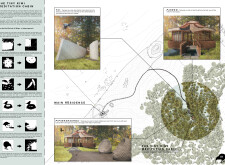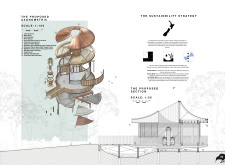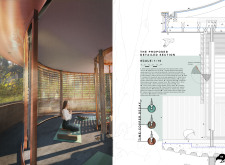5 key facts about this project
The cabin functions as a meditation retreat, offering areas for both solitary reflection and communal gathering. Its circular layout facilitates a flow between different zones, including spaces for meditation, teaching, and relaxation. The building's orientation and the deliberate interactions with the surrounding landscape enhance the user experience, encouraging mindfulness and a deeper appreciation for the natural environment.
Unique Design Approaches and Materiality
The architectural approach to the Tiny Kiwi Meditation Cabin stands out due to its circular design, which fosters inclusivity and a sense of belonging. The rotund shape contrasts with standard rectangular structures commonly seen in similar projects, facilitating a unique spatial experience that invites users to engage fully with the environment.
The material choices reflect both sustainability and a commitment to local resources. The use of concrete provides structural integrity and thermal mass, while NZ Macrocarpa timber not only adds warmth to the interior but also emphasizes the project’s connection to local materials. The copper roofing adds durability and a dynamic visual quality that evolves over time. Steel columns support the roof structure without obstructing sightlines, maintaining openness.
The integration of large glass panels fosters a connection between the interior and the exterior landscape, allowing natural light to permeate the space. This design element is critical for enhancing the calming atmosphere necessary for meditation. Additionally, the cabin employs strategies to manage thermal comfort and light reflection, reducing the need for artificial lighting and climate control systems.
Architectural Detailing and Functionality
The architectural detailing in the Tiny Kiwi Meditation Cabin plays a crucial role in its overall functionality. The seamless transitions between indoor and outdoor spaces encourage movement and interaction. Incorporating outdoor seating areas facilitates communal activities, reinforcing the collective aspect of meditation practice.
The building’s design includes significant attention to stormwater management, which integrates with the surrounding landscape and mitigates environmental impact. This strategy emphasizes the project’s sustainability ethos, aligning with contemporary architectural practices focused on ecological responsibility.
For a comprehensive understanding of the Tiny Kiwi Meditation Cabin, readers are encouraged to explore the architectural plans, sections, designs, and ideas that illustrate the project in greater detail. These elements provide deeper insights into how the design encapsulates the principles of mindfulness, cultural identity, and environmental harmony.


























